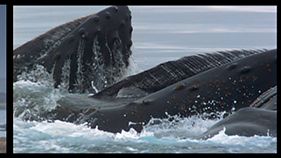
Press release -
Bildmuseet: John Akomfrah / Vertigo Sea
BAC–Baltic Art Center and Bildmuseet, Umeå University, are pleased to announce their partnership in supporting the production of John Akomfrah’s Vertigo Sea at the 56th Venice Biennale, All the World's Futures, curated by Okwui Enwenzor and in its Swedish premiere at Bildmuseet on October 25th. Akomfrah’s presentation, Vertigo Sea is a new three-screen film installation, which forms a meditation on whaling, the environment and our relationship to the sea.
Bildmuseet in collaboration with BAC–Baltic Art Center.
For the last 30 years and spanning cinema, television, and gallery-based installations, John Akomfrah's work has engaged with questions of memory and identity, creating moving-image works which give a voice to the legacy of the African Diaspora in Europe. He fills the voids in history using archival material to create film essays and speculative fictional stories about our collective past. His innovative works, expanding the boundaries of the documentary form and the format of the film essay. In his poetic and polyphonic films, Akomfrah creates sensual audio-visual experiences while simultaneously exploring a filmic language that may comprehend the trauma and sense of alienation of displaced subjects.
John Akomfrah was born in 1957 in Accra, Ghana. He lives and works in London. He co-founded the seminal media group Black Audio Film Collective. His work has been shown in museums and galleries including the Liverpool Biennial 2012; Documenta 11, Kassel; the De Balie, Amsterdam; Centre Pompidou, Paris; the Serpentine Gallery and Whitechapel Art Gallery, London; and MoMa, New York. A major retrospective of Akomfrah's gallery-based work with the Black Audio Film Collective premiered at FACT, Liverpool and Arnolfini, Bristol in 2007. His films have been included in international film festivals such as Cannes, Toronto, Sundance, amongst others. Akomfrah has served on numerous film festival juries and as a member of many documentary festival committees. In February 2003, the Britain’s Screen Nation Film and TV Awards, awarded him their most prestigious accolade, a Life Time Achievement Award for his “pioneering and overwhelming contribution to a black and British cinema culture.”
Vertigo Sea is a Smoking Dogs Films production supported by Sharjah Art Foundation, BBC Natural History, British Film Institute, Arts Council of England, BAC–Baltic Art Center, Bildmuseet, the Swedish Arts Council, and Tyneside Cinema Gallery.
For more information, please contact
Katarina Pierre, Director at Bildmuseet
katarina.pierre@bildmuseet.umu.se, 090-7869632
www.bildmuseet.umu.se
Livia Paldi, Director at BAC–Baltic Art Centre
livia@balticartcenter.com, 0498-200335
www.balticartcenter.com
Topics
Categories
Bildmuseet exhibits contemporary international art, photography, architecture, design and other forms of visual culture. Existential, political and philosophical issues are key to the programme. Bildmuseet received a Special Commendation from the European Museum of the Year jury last year, and was one of the top candidates för the Swedish Museum of the Year Award as well as for the Council of Europe Museum Prize.
Bildmuseet is a part of Umeå University. It is housed in an acclaimed building at the Umeå Arts Campus, right next to the Umeå Academy of Fine Arts, Umeå Institute of Design, Umeå School of Architecture and Humlab-X. Umeå university is a multifaced university where studies and research within the creative realm make up an important part of the universty's cornerstone. It is one of Sweden's largest institutions of higher learning with over 32,000 students and 4,200 employees.

